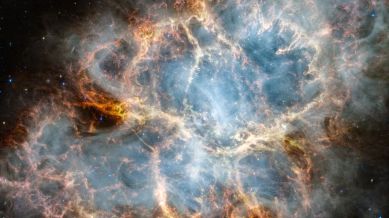Exquisite new details of Crab Nebula captured by Webb Telescope
The James Webb Space Telescope has captured never-before-seen details of the Crab Nebula.

The explosion of a star, a supernova recorded in the year 1,054 AD by 11th-century astronauts, led to the creation of the Crab Nebula, a supernova remnant. Now, the James Webb Space Telescope has looked at the nebula that is located 65,000 light-years away in the constellation Taurus, revealing exquisite new details that have never been seen before.
A team of researchers is looking for answers about the Crab Nebula’s origins, and they turned to Webb’s NIRCam and MIRI (Mid-Infrared Instrument) imagers.
Apart from that, some additional aspects that throw light on the inner workings of the Crab Nebula are more prominent and can be seen in greater detail in the infrared light captured by Webb.
Webb is particularly good at highlighting “synchrotron radiation,” which is the emission produced by charged particles like electrons moving around magnetic field lines at near relativistic speeds. That radiation appears in the image in the form of smoke-like material throughout the Crab Nebula’s interior. That is a product of the nebula’s pulsar, which is a rapidly rotating neutron star. The strong magnetic fields of the pulsar accelerate particles to extremely high speeds and make them emit radiation as they wind around the field lines.
If you trace the wispy material that creates a circular ripple-like pattern in the middle, you can locate the Crab Nebula’s pulsar heart. Follow the thin white ribbons of radiation farther out from the core. There, the curvy wisps are grouped together closely, outlining the structure of the pulsar’s magnetic field.